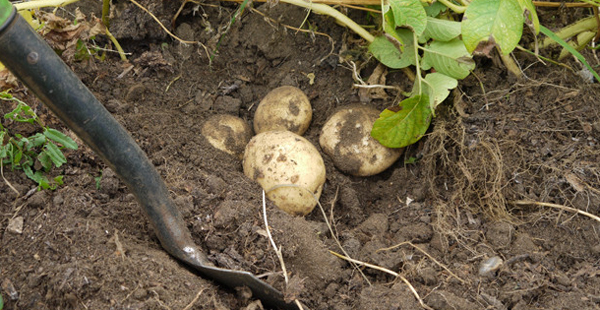If you’ve been sitting on the couch watching TV all winter, then it’s time to get off the couch and plant those potatoes! Potatoes are an easy and fun crop to grow and one that is especially good if you have children because of the fun they’ll have digging in the dirt to harvest them. Follow a few simple instructions and you’ll have a harvest to be proud of!
Begin by selecting good, firm seed potatoes. There are many varieties which do well in our area- Kennenec, Yukon Gold, Durango Red, and Red Sangre to name a few. Potatoes grow in average soil so you don’t really need to do much preparation, if your soil is fairly good. If not, be sure to work it well to loosen it up. You may want to add some top soil, peat moss, compost, or other amendment to help to loosen it, if you have very heavy clay soil. Remember, potatoes are a root crop and those roots need room to grow. Don’t use manure or lime- those will cause scab which may make them inedible. However, the addition of a good, balanced vegetable fertilizer tilled into the soil will help enormously. Till the soil to a depth of about 10-12″.
If the potatoes you have chosen are small, you can plant the entire potato. If they are larger, then cut them into pieces being sure that you have two to three “eyes” in each section. Let the sections callus over by letting them dry for a couple of days before planting.
Plant your potatoes several inches deep. A good rule of thumb is to plant them as deep as the size of the piece you are planting. In other words, if your piece is about three inches across, plant them about three inches deep. Make sure they stay covered and many folks will add soil to the top after planting as the season goes on and the plant begins to grow. This is called “mounding.” Often several pieces are planted in one mound, and soil is added as the potatoes develop. If they are not kept covered, they may work their way to the surface and that’s when the green color develops that you sometimes see on them. The green is not poisonous, contrary to popular belief, but does make them undesirable because of the bitter taste.
This information is from the Idaho Potato Commission:
“The green color that potatoes sometimes turn is not poison, here an explanation of what is going on: The greenish color sometimes seen on potato skins occurs when the potatoes have been exposed to natural, artificial, or fluorescent lights. This can also occur if when a potato is growing a crack in the soil exposes the potato to sunlight. This is mostly discovered before being sold.
Greening happens a lot more than it used to because supermarkets are often open for longer hours so their displays receive more direct light. However, it can also happen at home if you store your potatoes out in the open where they are exposed to light.
The green color on the potato is chlorophyll developing in the skin and along with this change, increased quantities of solanin are also formed. Solanin is part of the flavoring complex that gives the potato its taste. This is concentrated close to the potatoes surface and is easily removed when peeled. Only if the potato has prolonged exposure to light will the bitter taste and color penetrate deeper into the potato.
We recommend that you don’t eat the green part of the potato because of its bitter taste. Just peel away the green sections before preparing the potatoes and serving to your guests.”
Keep your potatoes watered, but remember that potatoes are like people- neither like wet feet! And, since they are a root crop, overwatering is easy to do. Generally, water a couple of times each week, depending on the outside temperatures and wind.
Potatoes are fun because they are one crop that can be harvested at different times. If you favor new potatoes, then harvest them early- generally when the plant begin to flower. If you want a fully developed potato, then wait until the vines turn yellow or have died back in the fall. Store potatoes in a dark, cool spot – temperatures at about 40 degrees are ideal.

